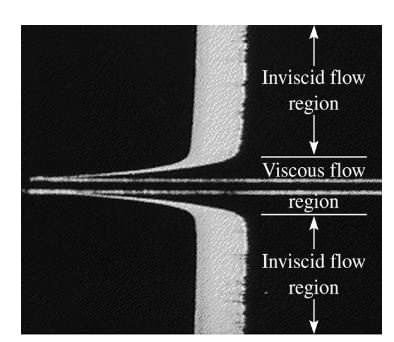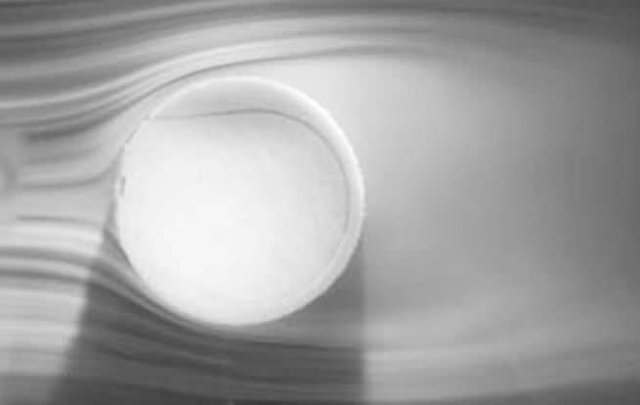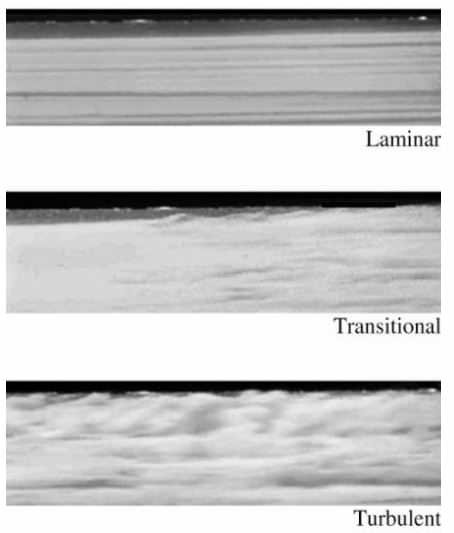001 Fluid Dynamics [ Revision 221]
Fluid Dynamics Introduction
What Is a Fluid?
Solids:
A solid can resist an applied shear stress by deforming and the stress is proportional to the strain.
Fluids:
Are liquids or gases, they deform continuously when under the influence of a shear stress and the stress is proportional to the strain. Liquids and gasses behave slightly different from each other.
- Liquid:
molecules are relatively free to change their position but are restricted by cohesive forces to maintain a relatively fixed volume. - Gas:
molecules are practically unrestricted by cohesive forces and expand to fill any volume.
Fluid mechanics is concerned with the net effect of the molecules at a macroscopic level and not concerned with the how the molecules are interacting with each other. For example the pressure in a reservoir can be measured by installing a pressure gauge.
The No Slip Condition
Fluid is often confined or restricted by solid surfaces, for example in pipes or surrounding a hull etc, it important to understand how the fluid behaves when interacting with a solid surface. In other words how the solid surface effects the flow of the fluid.
Fluids will tend to stick to the solid surface as it makes contact. that is to say that the fluid at the point of contact, comes to a complete stop (zero velocity) relative to the surface. This is caused by what is called, the fluids viscosity. The region of flow immediately surrounding this is called a boundary layer. This is partially what resists your boat/kayak/vessel especially at slow speeds.
Viscous vs Inviscid Flow

- Viscous:
Flows, such that the frictional effects significant, for example a boundary layer of plate/hull etc. - Inviscid:
The region (typically away from the solid surface) where viscous forces are negligibly small compared to intertial or pressure forces.
Internal vs External Flow
- Internal:
Flows which are bounded by a solid e.g. in a pipe. - External:
Unbounded flow around a solid object, refer the following photo below.

Compressible vs In-compressible Flow
- compressible:
density of the fluid is variable, typically gases depending on the mach number. - In-compressible:
Density of the fluid remains nearly constant.

Classification of Fluid Flows
Laminar vs Turbulent

- Laminar:
Line of motion of the flow is ordered in parallel layers of fluid. - Transitonal:
the flow lines are constantly changing from laminar to turbulent - Turbulent:
the flow lines have no particular order, eddies are formed in the flow of fluid
The flow in a field can be described by its velocity distribution, a field of flow can have velocity in 1, 2 or 3 dimensions, therefore can be described as such. In some circumstances flow velocity along one axis will negligible in comparison to the other axis and then can be modeled in the most prevalent axis of flow. A pipe could be considerd 1 dimensional flow, however the outlet might be considered 3 dimensional as the liquid may not bounded by a solid.
The purpose of this post is to serve as revision for my study and as a resources, I can come back to as necessary.

Congratulations @rezantroy! You have completed some achievement on Steemit and have been rewarded with new badge(s) :
Click on any badge to view your own Board of Honor on SteemitBoard.
For more information about SteemitBoard, click here
If you no longer want to receive notifications, reply to this comment with the word
STOPCongratulations @rezantroy! You have completed some achievement on Steemit and have been rewarded with new badge(s) :
Click on any badge to view your own Board of Honor on SteemitBoard.
For more information about SteemitBoard, click here
If you no longer want to receive notifications, reply to this comment with the word
STOP